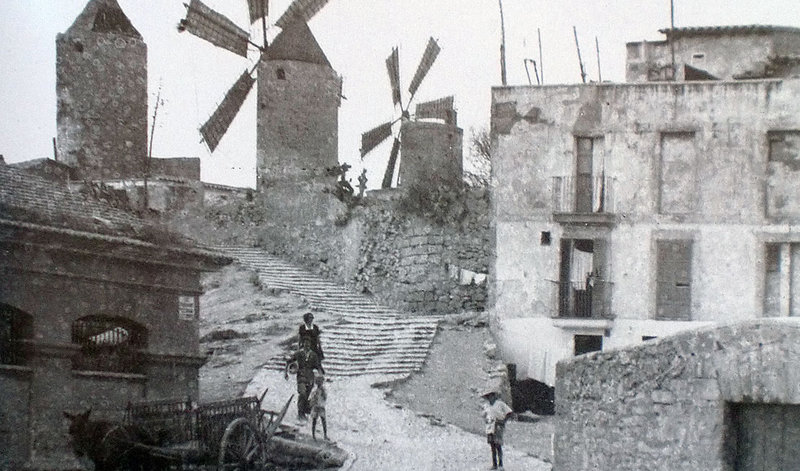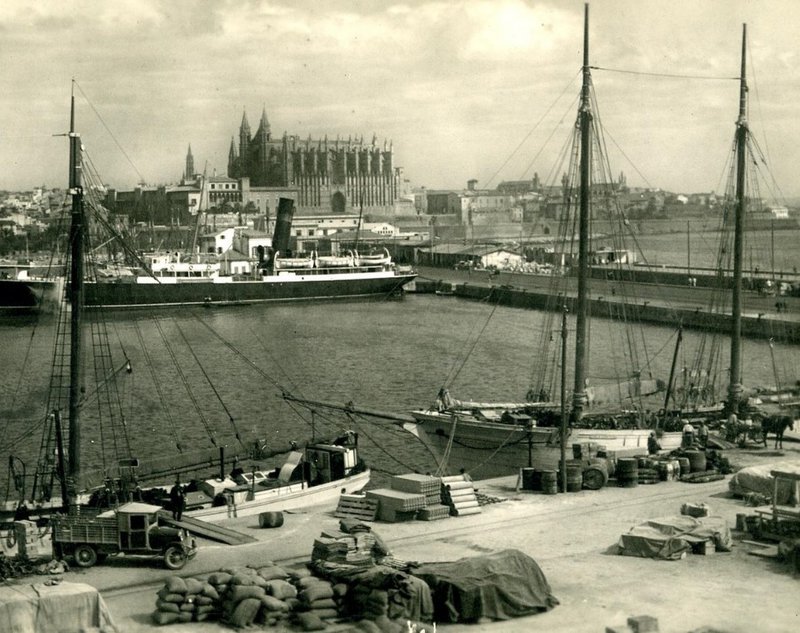Looting the Islands
The writer's affection for the Islands is not their beauty but the treasure trove of antiquities that she found there
Women Travellers in Catalan Lands
Take my advice and don't go to Palma in the summer. In spring and autumn it must be delightful, but now in July it is all so white and bare and glaring. I suppose we should have been wiser to stop at one of the hotels down by the shore, but then, they are very remote, and taxis are horribly expensive. After Barcelona prices it was a shock to pay four pesetas to drive two blocks! As it is, we are at the edge of a new development that some day, when it is adequately planted, will be quite attractive, but now our one relief, at the end of a torrid afternoon, is to climb up to be comfortably cool on the roof. [...]
And there are many churches, for Palma is a very religious place—if you blaspheme in the tramway you are haled before the civil authorities and fined! We have visited them all,—the churches, not the authorities,—the most interesting being Santa Eulalia, through whose portals Ramón Llull, the sinner, rode in pursuit of his innamorata, and San Francesco where he, beatified, is buried, and the place were locked in as we hunted through the dark aisles for his tomb. I am sorry to destroy a legend, but a light does not unceasingly burn before his marble effigy; we never should have found it without the aid of a young priest who heard us clamoring to be released, and came to our rescue. But pray don't think him a prophet without renown; here in Mallorca he has great honor, and even shops are named after this holy man. [...]
But nothing in the whole city, not even the superb Lonja, is so magnificently beautiful as the Cathedral, that great Ship of God forever moored by a perpetually blue sea. The approach, too, is gracious; up a wide stairway street, the walls hung with a tapestry of ivy-geraniums, and plumbago, roses and lavenders woven upon a dense background of green. You pass the Almudaina, once the ancient palace of the Moorish kings, then cross the plaza to the Cathedral, the church to “Our Lady, Saint Mary”, that Don Jaime built directly after the Conquest.[...]
Perhaps [...]the most remarkable thing about the Cathedral is that no antiquity shops cluster round its base; hence my visits were purely spiritual. Not that my enthusiasm wanes; I have been back several times to Casas's warehouse, for the two larger Palma antigüedades are closed in the summer, and all I could do was to look through the high iron gates and watch the pomegranates spilling their crimson blossoms over the patios. [...] I got the setee; I knew Orde couldn't resist it, antiquer though he isn't. And for fifteen pesetas I bought one of the finest trays I have ever seen—a great pie-crust, black, with a glowing centre of powdered gold and a very gay long-tailed bird. Spain undoubtedly is the country for trays; a piece like this would cost six pounds in England and seventy-five dollars at home.
And I got some pretty, vivid tiles for a peseta each, and for you, and the new house in Norwich, two odd little wrought-iron knockers, the sort that decorate the old doors in the Cathedral close—five pesetas for the pair. Except the settee, my only other purchase that amounted to anything was an oak box, seventeenth-century, I should think, and very rustic; probably meant to hold some peasant girl's jewelry. The carving is charming, though rather naïve: four massive lion's-claw feet, two little fishes on either side of the keyhole, a modified egg and dart pattern round the edge, and, best of all, the lid inlaid in lemonwood with some of the designs that adorn the great fourteenth-century Murador portal of the Cathedral—the sun and moon and a heart pierced with arrows. I wonder if it belonged to the daughter of some layman in the Church's service. [...]
For almost twice as much I could have bought an excellent knife box, mahogany, with a marquetry of Sheraton shells. You may think this a strange thing to find so far away from home, and it is amazing to see so much furniture of the English type lying about. The explanation is simple enough: off and on through the eighteenth century, Minorca, the second of the Balearic group, was under British control, and a great deal of furniture was either made here under this influence or else brought from overseas. I could have bought drop-leaf tables, slant-top desks, and chests of drawers for about a fifth of what I should have had to pay in England. Before you furnish your house, come over with me, and [...] we'll loot the Islands.
Alice Van Leer Carrick
Pere GifraDuring the early twentieth century, many wealthy Americans relied on an extensive network of dealers, agents and auctioneers to purchase abroad the expensive art objects that later on they carefully treasured in their stately mansions at home. For those with equally artistic propensities yet emptier pockets, the solution was to travel, haggle and purchase the decorative wares on their own. This is true of Alice Van Leer Carrick (1875-1961), who during the inter-war period popularized the hobby of antique collecting among middle-class Americans thanks to a number of books, articles and lectures at women's clubs and fine arts societies. She believed that collecting was not so much about owning objects as about tracing and contextualizing them, and that thanks to their contemplation and study one could gain a wider knowledge of the cultures they came from. Born in Nashville, Tennessee, Carrick was educated in Roxbury and Bosto, and began writing at the age of 18, mostly stories for children. In 1901 she married Prescott Orde Skinner, a professor of Romance Languages at Dartmouth College, New Hampshire, and resided in an on-campus cottage that, after years of incessant antique-hunting, became a true museum of colonial heirlooms. Helen Sheumaker notes that Carrick “supported the Colonial Revival aesthetic, which embodied ideals of patriotic virtue in contrast to the supposed decline in morality and in the conduct of life in her era”.




